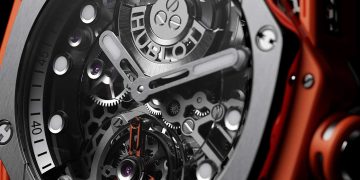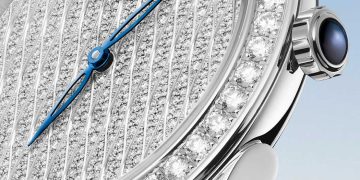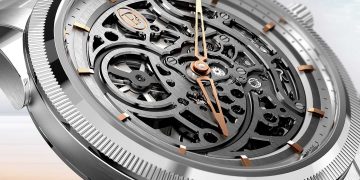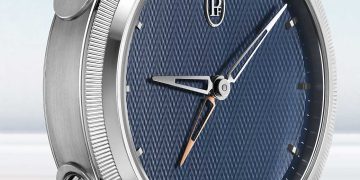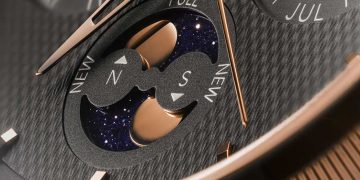
MB&F and L’Epée 1839 present Grant, a triple-tracked, Mad-Max-cross-Transformer robot clock on a mission. In today’s fast-paced, always-on, 24/7 world, we are under constant bombardment from time: seconds race by; there is never enough; everyone wants more; and it keeps getting faster and faster. The nearest hour was once precise enough; now the world’s most accurate clocks are better than a second over the entire age of the universe!
No wonder you are stressed, but relax, help is at hand. Grant is here. Grendizer meets Mad Max meets Transformer.
Grant is a robot with a time display on his shield and a mission to slow things down when time runs too fast. There are no incessantly flashing digital numerals on Grant’s shield, no constantly spinning second hand. Grant transforms frantic chaos into relaxing hours and minutes, and that’s all the time you really need.
While Grant’s time moves relatively slowly, he can travel quickly over rough terrain (or the messiest desk) on his three operational rubber tracks. Grant can also transform into one of three different modes: lying horizontally over his chassis for a low profile; crouching at 45 degrees; and sitting up 90 degrees. Grant’s time shield can always be set to a comfortable and optimal viewing angle.
Whatever the angle, Grant’s highly polished clockwork is on full display, and you can follow every click and turn of the gears. The mainspring barrel click near his ‘belly button’ is particularly mesmerizing in operation. The isochronal oscillations of the regulator keeping time in Grant’s glass-domed ‘brain’ are evidence of the clockwork’s high precision. Watching Grant “thinking” in real time is a stress-relieving activity in itself: Grant transforms time so that you can relax and enjoy it.
Grant’s 8-day, in-line manufacture movement features the same superlative fine finishing as found on the finest wristwatches: Geneva waves, anglage, polishing, sandblasting, plus circular and vertical satin finishing. Hand finishing a clock movement is significantly more challenging than that of a wristwatch due to the larger surface areas of the clock components.
While he doesn’t look for fights, Grant believes offense is a great form of defense and packs appropriate weaponry. His left arm holds a “you-really-don’t-want-to-mess-with-me” spinning disk, while his right arm clasps a removable grenade launcher. Grant even has a surprise up his sleeve: his grenade launcher is removable and doubles as the winding and time-setting key for his 8-day clockwork, so he isn’t likely to run out of either firepower or time.
Grant is available in three limited editions of 50 pieces each in Nickel, Black, and Blue.
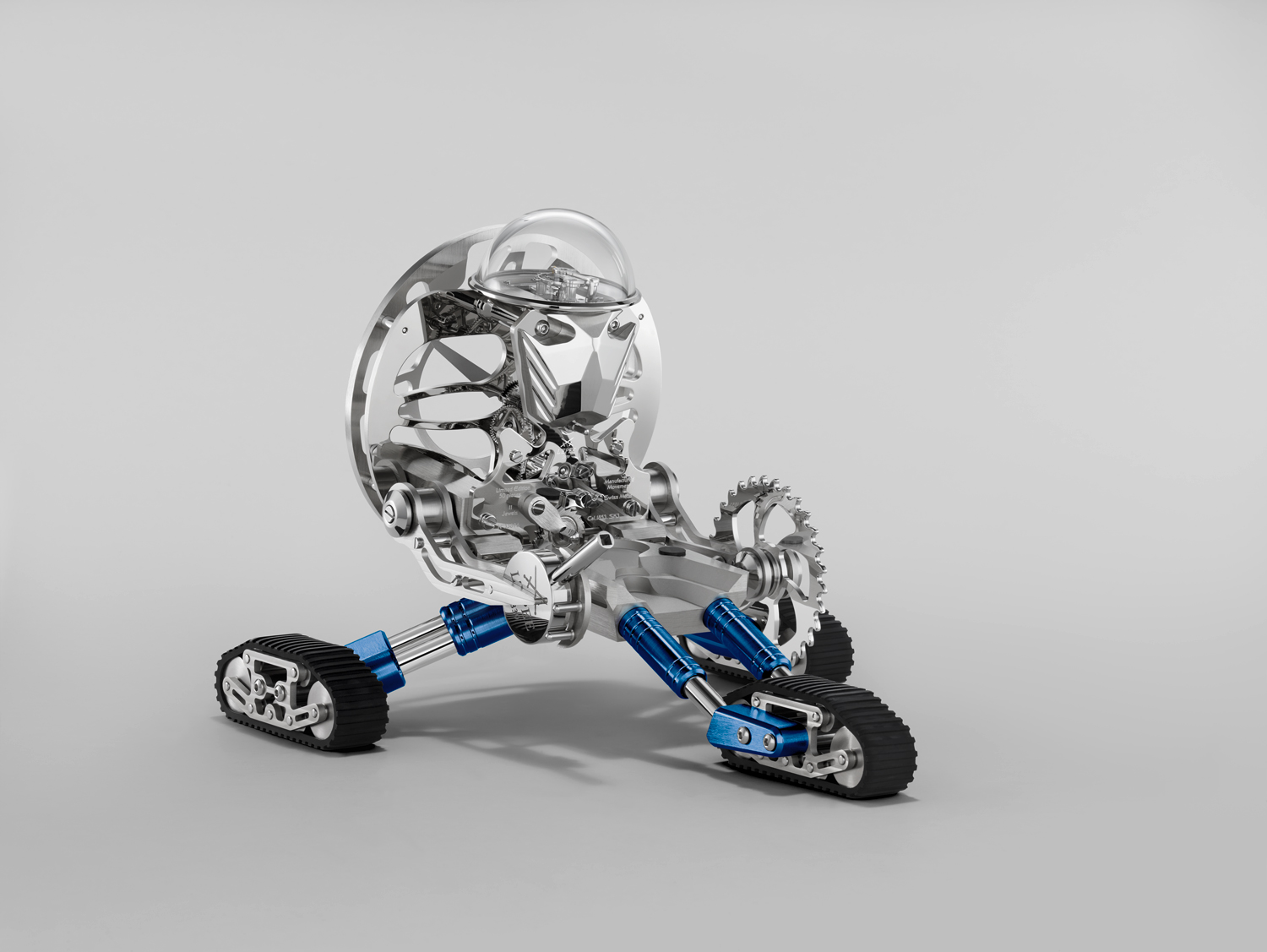
Grant’s timekeeping
L’Epée 1839 developed Grant to MB&F’s design using its 8-day, in-line manufacture movement as a structural base. Grant doesn’t just look like a complicated piece of high-precision micro-engineering, he is an incredibly solid piece of complex high-precision micro-engineering with an impressive 268 components going into the construction of his body and clockwork. That’s more pieces than in many complicated wristwatches.
Under the transparent mineral glass dome on Grant’s “head”, the clock movement’s regulator – consisting of the balance and escapement – features an Incabloc shock protection system to minimise the risk of damage when the clock is moved or transported. Shock protection is standard in wristwatch movements; however, it is unusual in clocks, which are generally stationary. But then Grant is no stationary clock; he is a robot on a mission to transform time.
Contrary to what you might expect, hand finishing a clock movement is actually significantly more challenging than that of a wristwatch due to the larger surface areas of the clock components. Grant’s 8-day movement features a mix of Geneva waves, anglage, polishing, sandblasting, circular and vertical satin finishing.
Grant’s transformer powers
Grant transforms into three positions, each with a practical purpose.
Position 1: Grant’s torso folds flat in his lap with his shield/time display lying horizontal across his back. This flat position enables the time to be easily read if Grant is significantly lower than the viewers’ eyes and, in this relatively stable position, the winding key will wind the 8-day mainspring.
Position 2: Grant’s torso locks securely into place at 45 degrees, from which he transforms into a more recognisably robotic shape. In this angled position, if resting on a desk or table, the time display is easily seen whether the viewer is sitting or standing.
Position 3: Grant’s torso sits up straight at 90 degrees to his chassis, with his shield now lying vertically along his back. In this position, Grant looks most like the Mad Max warrior he sometimes longs to be (that’s AI for you) and the key will now set the time.
However (and please keep this to yourself), the real reason Grant transforms into three different modes is that it gives us three different ways to play!
What’s in a name? The Grant Tank, aka Medium Tank, M3
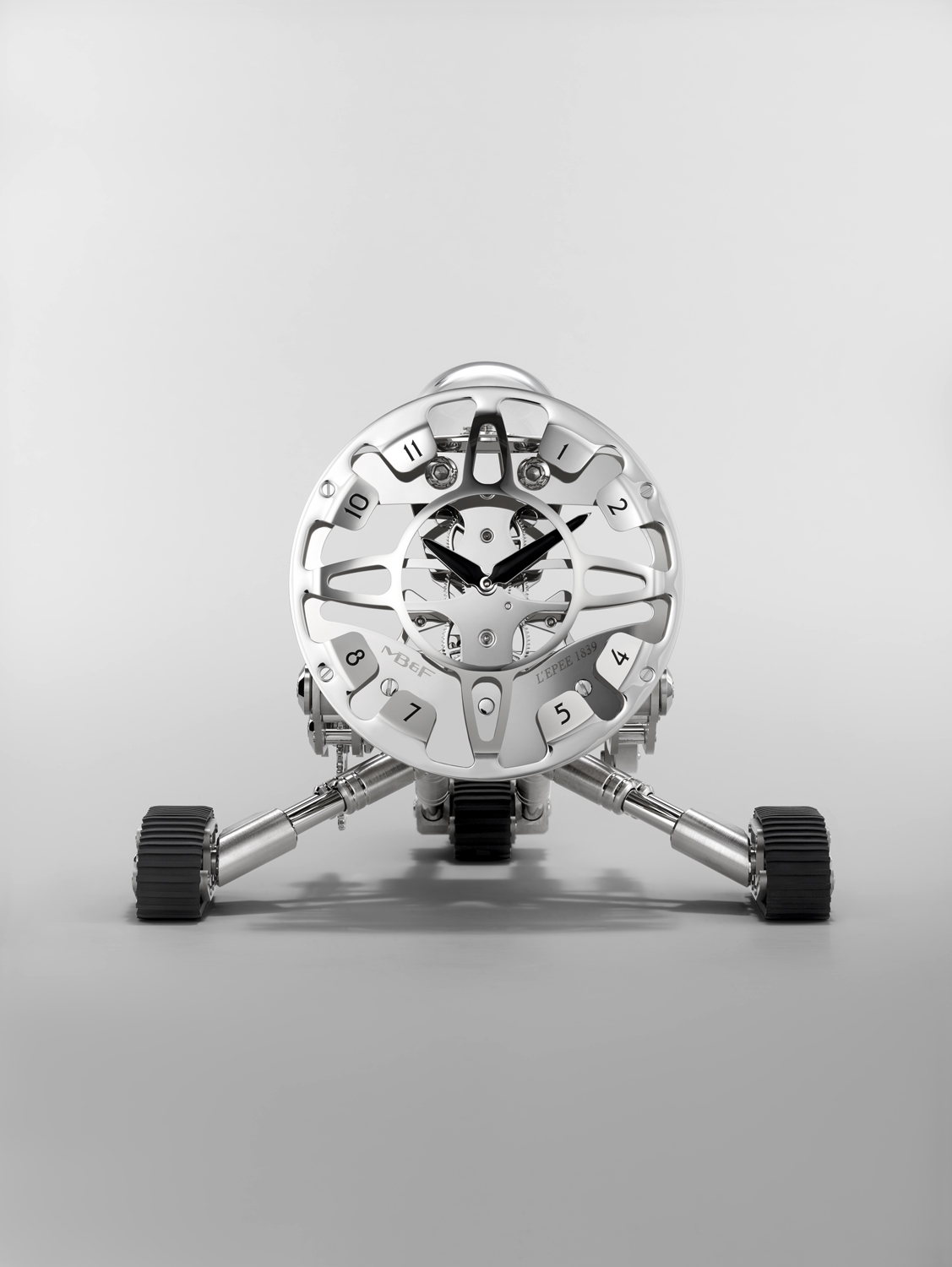
Medium Tank, M3, was a medium-sized American tank in use during World War II. In Britain, the tank came in two variations with differing turret configurations and crew sizes and each model was naturally given its own name. The Brits nicknamed the American-turreted tank “Lee”, after Confederate general Robert E. Lee; the British-turreted tank was called “Grant”, after Union general Ulysses S. Grant.
The M3 tank had significant firepower (like MB&F’s + L’Epée 1839’s Grant) and was well armoured (unlike Grant). The M3’s drawbacks included a high silhouette and poor off-road performance, both issues rectified in the Grant: low profile (when laying flat) and excellent high-speed off-road performance (thanks to the three tracks).
General Ulysses Simpson Grant held the highest positions in both the military and the government of the United States. He led the Union Army to victory over the Confederacy with the supervision of Abraham Lincoln. As President of the United States (1869–77) Grant led the Republicans in their efforts to remove the vestiges of Confederate nationalism and slavery during Reconstruction.
Grant: technical specifications
Grant is available in three limited editions of 50 pieces each in Nickel, Black, and Blue.
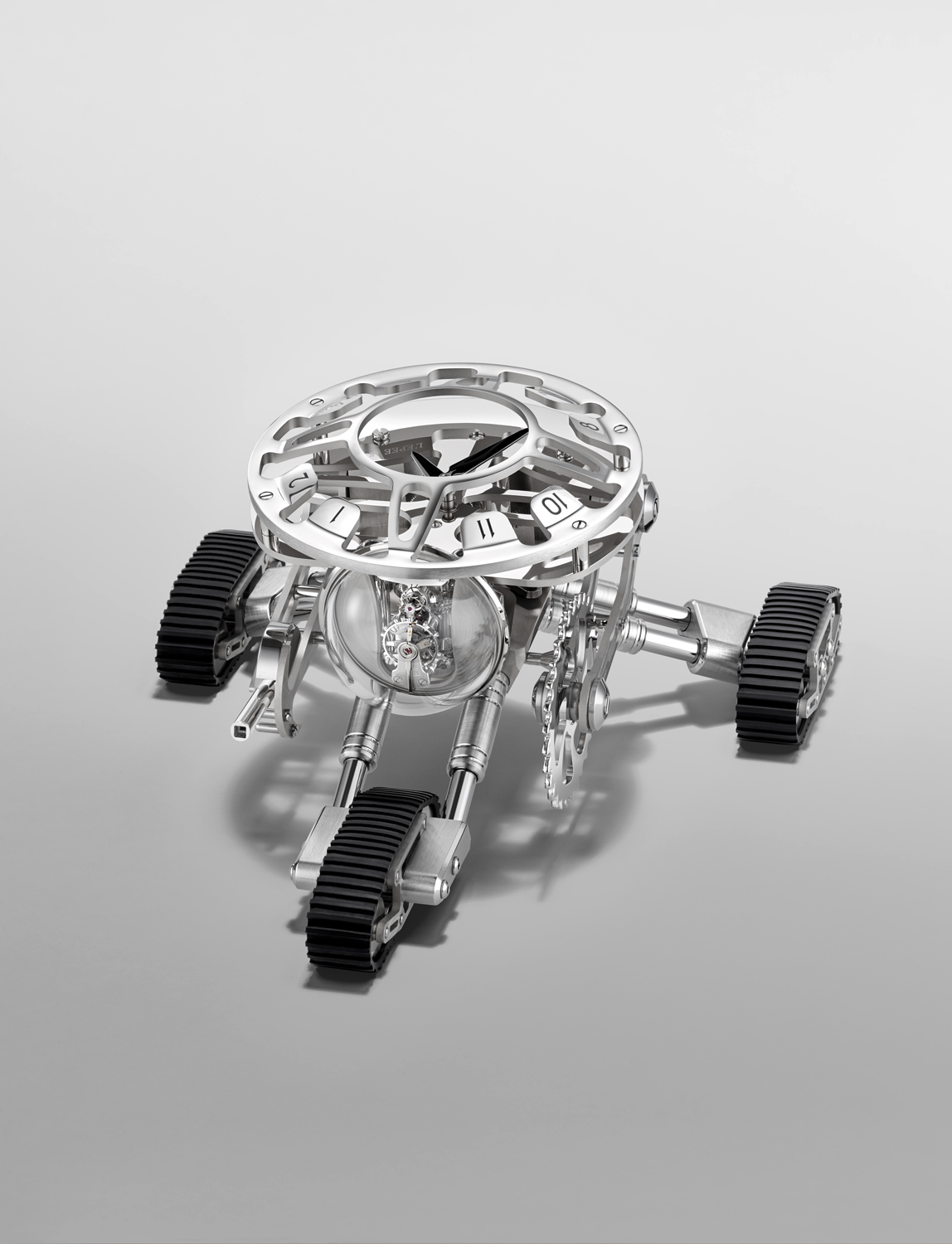
Display
Hours and minutes
Size
Dimensions:
Truck: 115 mm tall x 212 mm wide x 231 mm long
Robot: 166 mm tall x 212 mm wide x 238 mm deep
Components total: 268
Weight: 2.34 kg
Body/frame
Transformer body with three operational tracks and three positions of clock/body.
Materials: stainless steel, nickel-plated brass, palladium-plated brass.
Dome/head: mineral glass.
Engine
L’Epée in-house designed and manufactured in-line eight-day movement
Balance frequency: 2.5 Hz / 18,000 bph
Power reserve: 8 days
Components movement: 155
Jewels: 11
Incabloc shock protection system
Movement finishing: Geneva waves, anglage, polishing, sandblasting, circular and vertical graining, satin finishing.
Winding: key on right hand doubles as weapon and pulls out to reveal a double-depth square socket key that both sets the time and winds the movement (on the back/dial side of the clock).
L’EPEE 1839 – the premier clock manufacture in Switzerland
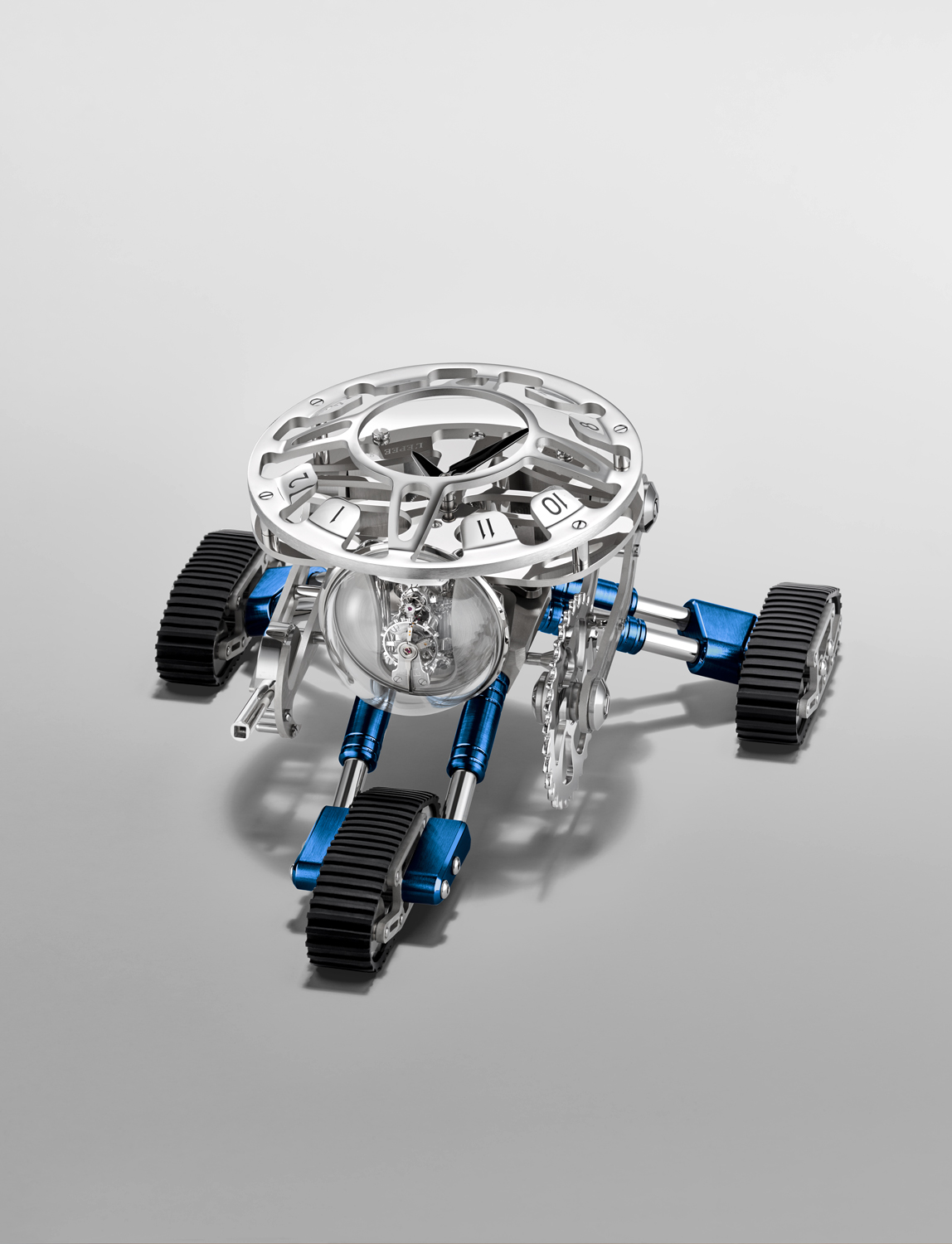
For more than 175 years, L’Epée has been at the forefront of clock making. Today, it is the unique specialised manufacture in Switzerland dedicated to making high-end clocks. L’Epée was founded in 1839, by Auguste L’Epée, who set up the business near Besançon, France to make music box and watch components.
From 1850 onward, the manufacture became a leading light in the production of ‘platform’ escapements, creating regulators especially for alarm clocks, table clocks and musical watches. By 1877, it was making 24,000 platform escapements annually. The manufacture became a well-known specialist owning a large number of patents on special escapements such as anti-knocking, auto-starting and constant-force escapements and the chief supplier of escapements to several celebrated watchmakers of the day. L’Epée has won a number of gold awards at international exhibitions.
During the twentieth century, L’Epée owed much of its reputation to its superlative carriage clocks and, for many, L’Epée was the clock of the influential and powerful; it was also the gift of choice by French government officials to elite guests. In 1976 when the Concorde supersonic aircraft entered commercial service, L’Epée wall clocks were chosen to furnish the cabins, providing passengers with visual feedback of the time. In 1994, L’Epée showed its thirst for a challenge when it built the world’s biggest clock with compensated pendulum, the Giant Regulator. At 2.2 m high, it weighs 1.2 tons – the mechanical movement alone weighs 120 kg – and required 2,800 man-hours of work.
L’Epée is now based in Delémont in the Swiss Jura Mountains. Under the guidance of CEO Arnaud Nicolas, L’Epée 1839 has developed an exceptional table clock collection, encompassing a range of sophisticated classic carriage clocks, contemporary design clocks and avant-garde horological sculptures. L’Epée clocks feature complications including retrograde seconds, power reserve indicators, perpetual calendars, tourbillons and striking mechanisms – all designed and manufactured in-house. Ultra-long power reserves have become a signature of the brand as well as superlative fine finishing.
MB&F – Genesis of a Concept Laboratory
In 2015, MB&F celebrated its 10th anniversary – and what a decade it was for the world’s first ever horological concept laboratory: 10 years of hyper-creativity; 11 remarkable calibres forming the base of the critically acclaimed Horological Machines and Legacy Machines for which MB&F has become renowned.
After 15 years managing prestigious watch brands, Maximilian Büsser resigned from his Managing Director position at Harry Winston in 2005 to create MB&F – Maximilian Büsser & Friends. MB&F is an artistic and micro-engineering laboratory dedicated to designing and crafting small series of radical concept watches by bringing together talented horological professionals that Büsser both respects and enjoys working with.
In 2007, MB&F unveiled its first Horological Machine, HM1. HM1’s sculptured, three-dimensional case and beautifully finished engine (movement) set the standard for the idiosyncratic Horological Machines that have followed: HM2, HM3, HM4, HM5, HM6, HM7, HM8 and HMX – all Machines that tell the time, rather than Machines to tell the time.
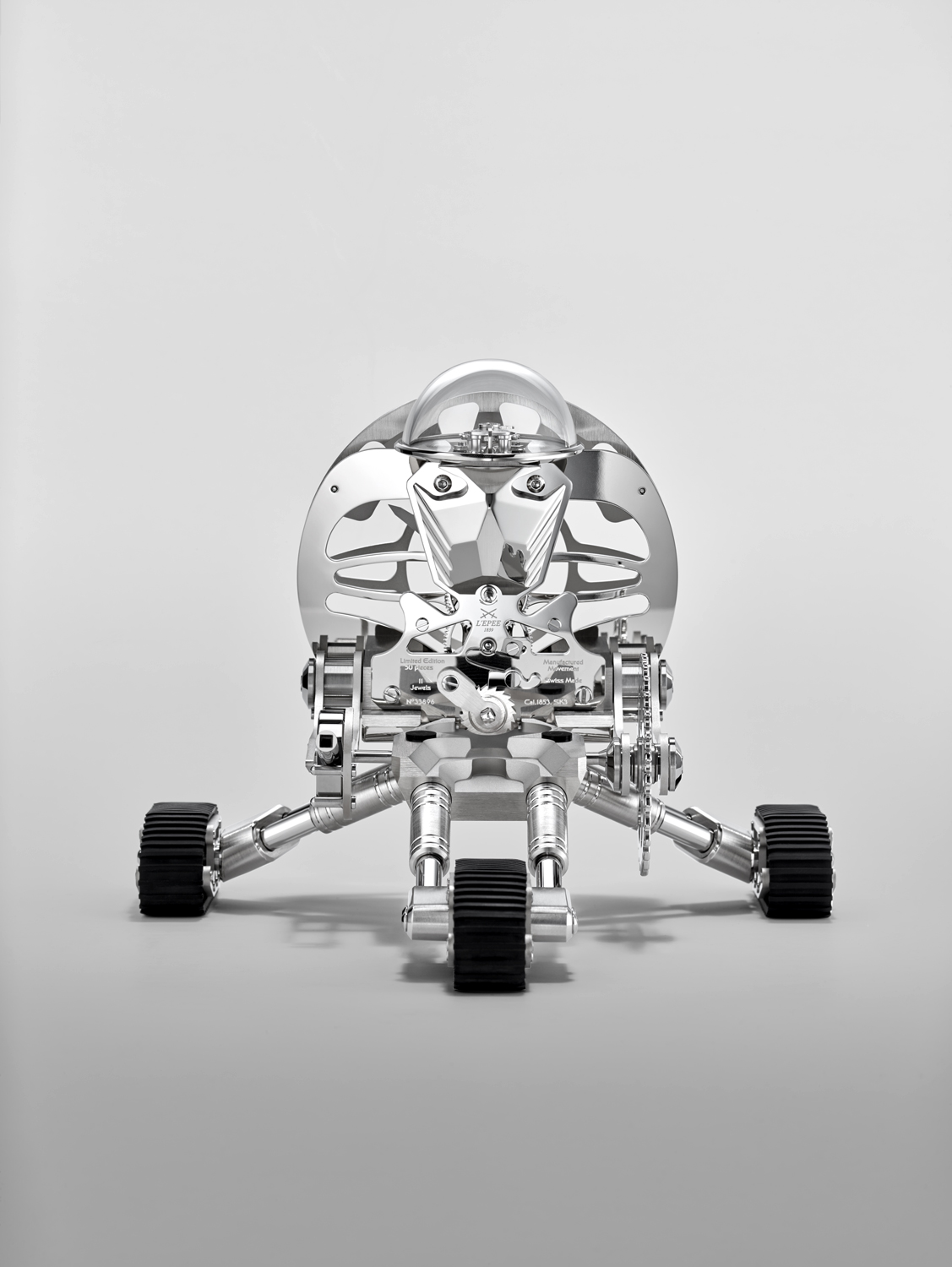
In 2011, MB&F launched its round-cased Legacy Machine collection. These more classical pieces – classical for MB&F, that is – pay tribute to nineteenth-century watchmaking excellence by reinterpreting complications from the great horological innovators of yesteryear to create contemporary objets d’art. LM1 and LM2 were followed by LM101, the first MB&F Machine to feature a movement developed entirely in-house. The year 2015 saw the launch of Legacy Machine Perpetual featuring a fully integrated perpetual calendar. LM SE was launched in 2017. MB&F generally alternates between launching contemporary, resolutely unconventional Horological Machines and historically inspired Legacy Machines.
As well as Horological and Legacy Machines, MB&F has created space-age MusicMachines (1, 2 and 3) in collaboration with music box specialist Reuge; and with L’Epée 1839, unusual clocks in the form of a space station (Starfleet Machine), a rocket (Destination Moon), a spider (Arachnophobia), an octopus (Octopod) and three robot clocks (Melchior, Sherman, and Balthazar) – as well as a mechanical weather station (The Fifth Element). In 2016, MB&F and Caran d’Ache created a mechanical rocket-pen called Astrograph.
And there have been distinguished accolades reminding us of the innovative nature of MB&F’s journey so far. To name a few, there have been no less than 4 Grand Prix awards from the famous Grand Prix d’Horlogerie de Genève: in 2016, LM Perpetual won the Grand Prix for Best Calendar Watch; in 2012, Legacy Machine No.1 was awarded the Public Prize (voted for by horology fans) and the Best Men’s Watch Prize (voted for by the professional jury). In 2010, MB&F won Best Concept and Design Watch for the HM4 Thunderbolt. In 2015 MB&F received a Red Dot: Best of the Best award – the top prize at the international Red Dot Awards – for the HM6 Space Pirate.

